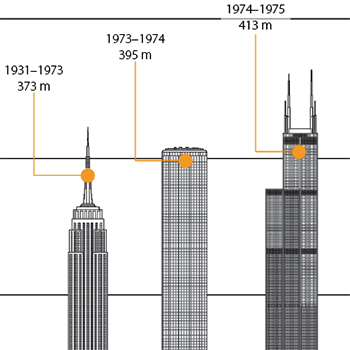Height rank
One Prudential Plaza
Chicago
-
Metrics
You must be a CTBUH Member to view this resource.
Official Name
One Prudential Plaza
Other Names
Prudential Building
Name of Complex
Type
Building
Status
Completed, 1955
Country
City
Address
Postal Code
60601
Function
A mixed-use tall building contains two or more functions (or uses), where each of the functions occupy a significant proportion of the tower's total space. Support areas such as car parks and mechanical plant space do not constitute mixed-use functions. Functions are denoted on CTBUH "Tallest Building" lists in descending order, e.g., "hotel/office" indicates hotel function above office function.
office
Structural Material
Both the main vertical/lateral structural elements and the floor spanning systems are constructed from steel. Note that a building of steel construction with a floor system of concrete planks or concrete slab on top of steel beams is still considered a “steel” structure as the concrete elements are not acting as the primary structure.
Reinforced Concrete
Both the main vertical/lateral structural elements and the floor spanning systems are constructed from concrete which has been cast in place and utilizes steel reinforcement bars.
Precast Concrete
Both the main vertical/lateral structural elements and the floor spanning system are constructed from steel reinforced concrete which has been precast as individual components and assembled together on-site.
Mixed-Structure
Utilizes distinct systems (e.g. steel, concrete, timber), one on top of the other. For example, a steel/concrete indicates a steel structural system located on top of a concrete structural system, with the opposite true of concrete/steel.
Composite
A combination of materials (e.g. steel, concrete, timber) are used together in the main structural elements. Examples include buildings which utilize: steel columns with a floor system of reinforced concrete beams; a steel frame system with a concrete core; concrete-encased steel columns; concrete-filled steel tubes; etc. Where known, the CTBUH database breaks out the materials used in a composite building’s core, columns, and floor spanning separately.
steel
Official Website
Height
183.2 m / 601 ft
Floors Above Ground
41
# of Elevators
30
Tower GFA
163,787 m² / 1,762,989 ft²
-
By function
You must be a CTBUH Member to view this resource.
-
By material
You must be a CTBUH Member to view this resource.
Construction Start
Completed
You must be a CTBUH Member to view this resource.
Owner
Sterling Bay
Architect
Usually involved in the front end design, with a "typical" condition being that of a leadership role through either Schematic Design or Design Development, and then a monitoring role through the CD and CA phases.
Naess & Murphy
Structural Engineer
The Design Engineer is usually involved in the front end design, typically taking the leadership role in the Schematic Design and Design Development, and then a monitoring role through the CD and CA phases.
Naess & Murphy
Main Contractor
The main contractor is the supervisory contractor of all construction work on a project, management of sub-contractors and vendors, etc. May be referred to as "Construction Manager," however, for consistency CTBUH uses the term "Main Contractor" exclusively.
The main contractor is the supervisory contractor of all construction work on a project, management of sub-contractors and vendors, etc. May be referred to as "Construction Manager," however, for consistency CTBUH uses the term "Main Contractor" exclusively.
George A. Fuller Co.
Other Consultant
Other Consultant refers to other organizations which provided significant consultation services for a building project (e.g. wind consultants, environmental consultants, fire and life safety consultants, etc).
Other Consultant refers to other organizations which provided significant consultation services for a building project (e.g. wind consultants, environmental consultants, fire and life safety consultants, etc).
Iannelli Studio
Research

24 August 2015
World’s Highest Observation Decks
CTBUH Research
Perhaps no element of a tall building is more closely related to the pure pleasure of standing high in the sky and taking in the...
About One Prudential Plaza
When completed in 1955, One Prudential Plaza became the second tallest building in Chicago and ended a two-decade long hiatus of tall office building construction within the city due to the economic impacts of the Great Depression and World War II. At the time of the project’s conception, the site was a freight yard owned by the Illinois Central Railroad and required the use of air rights to construct the building above the active railroad tracks, a practice which was repeated for the adjacent buildings constructed later as part of the larger Illinois Center complex. While the freight yards have since disappeared, passenger service remains for commuter trains serving the South Side of Chicago, southern suburbs and Northern Indiana, with One Prudential Plaza offering direct access to the Millennium Station located beneath street level.
The façade of the mid-century building has hints of the previously popular Art Deco style, maintaining strong vertical lines of uninterrupted limestone piers separated by bays of recessed windows set into aluminum spandrels. The main entrance is set back from Randolph Street with an entry plaza flanked by two portions of the building’s lower floors that extend outward to the edges of the property. One of these extensions of the building’s lower floorplates features a portion of the façade dedicated to a relief of the Rock of Gibraltar by artist Alfonso Iannelli, representing the logo of the Prudential Company.
Subscribe below to receive periodic updates from CTBUH on the latest Tall Building and Urban news and CTBUH initiatives, including our monthly newsletter. Fields with a red asterisk (*) next to them are required.
View our privacy policy














